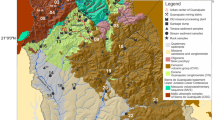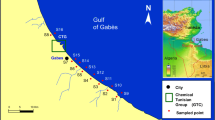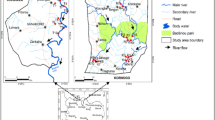Abstract
This work reports a geochemical study of sediments from the upper Paracatu River Basin. The objective is to define the influences of Au, Zn, and Pb mineral deposits and mining activities on the sediment metal sources, distribution, and accretion. The samples were analyzed using ICP/OES, AAS, and XRD techniques and were treated with principal components analysis and the geo-accumulation index. The main geochemical processes that control the sediment composition are pyrite oxidation, muscovite weathering, carbonate dissolution, and the erosion of oxisols enriched with Zn and Pb. The upper Rico Stream has high Al, Fe, Cu, Cr, Co, and Mn concentrations due erosion of oxisols and pyrite oxidation and muscovite alteration present in the parental rock. The artisanal alluvial gold mining increased the primary rock-minerals’ weathering and Hg sediment concentration. The lower Escuro River and Santa Catarina Stream are enriched with Zn and Pb due the erosion of metal-rich soils formed over galena, sphalerite, calamine, and willemite mineral deposits located upstream. Elements such as Ca, Mg, and Ba have low concentrations throughout the sampled area due the high solubility of these metals-bearing minerals. The dispersion of metals is limited by the basin geomorphology and their affinity to silt-clayey minerals and Fe and Mn oxides and hydroxides in circumneutral pH waters.



Similar content being viewed by others
References
Andrew-Jones DA (1968) The application of geochemical techniques to mineral exploration. Miner Ind Bull 2(6):1–31
Axe L, Trivedi P (2002) Intraparticle surface diffusion of metal contaminants and their attenuation in microporous amorphous Al, Fe and Mn oxides. J Colloid and Interface Sci 247:259–265
Banks D, Younger PL, Arnesen RT, Iversen ER, Banks SB (1997) Mine-water chemistry: the good, the bad and the ugly. Environ Geol 32(3):157–174
Burak DL, Fontes MPF, Santos NT, Monteiro LVS, Martins ES, Becquer T (2010) Geochemistry and spatial distribution of heavy metals in oxisols in a mineralized region of the Brazilian Central Plateau. Geoderma 160:131–142
Callaham JE, Miller JW, Craig JR (1994) Mercury pollution as a result of gold extraction in North Carolina, USA. Appl Geochem 9(2):235–241
Campos Neto MC (1984) Litoestratigrafia, relações estratigráficas e evolução paleogeográfica dos grupos Canastra e Paranoá (região de Vazante-Lagamar, MG). Rev Bras Geocienc 14(2):81–91
Chapman PM, Wang F (2000) Issues in ecological risk assessment of inorganic metals and metalloids. Hum Ecol Risk Assess 6:965–988
Dardenne MA (2000) The Brasília fold belt. In: Campos DA, Cordani UG, Thomaz Filho A (eds) Tectonic evolution of South America. International Geological Congress, Rio de Janeiro, pp 231–263
DNPM (1988) Principais depósitos minerais do Brasil. CPRM, Brasília
Drever JI (1988) The Geochemistry of natural waters, 2nd edn. Prentice Hall, New Jersey
Farnham IM, Johannesson KH, Singh AK, Hodge VF, Stetzenbach KJ (2003) Factor analytical approaches for evaluating groundwater trace element chemistry data. Anal Chim Acta 490:123–138
Fischer WR, Schwertman US (1974) The formation of hematite from amorphous iron(III) hydroxide. Clays Clay Miner 23:33–37
Fontes MPF, Gomes PC (2003) Simultaneous competitive adsorption of heavy metals by the mineral matrix of tropical soils. Appl Geochem 18:1143–1149
Förstner U (1983) Assessment of metal pollution in rivers and estuaries. In: Thornton I (ed) Applied environmental geochemistry. Academic Press, Londres, pp 395–423
Freitas-Silva FH, Dardenne MA (1992) Controles litoestruturais do depósito de ouro do Morro do Ouro, Paracatu, MG. Rev Esc Minas 45(3):216
Fuck RA, Jardim De Sá EF, Pimentel MM, Dardenne MA, Soares ACP (1993) As faixas de dobramento marginais do Craton do São Francisco. In: Dominguez JML, Misi A (eds) Sociedade Brasileira de Geologia
Grosbois CA, Horowitz AJ, Smith JJ, Elrick KA (2001) The effect of mining and related activities on the sediment trace element geochemistry of lake coeur D’Alene, Idaho, USA. Part III: the Spokane River Basin. Hydrol Process 15:855–875
Gruiz K, Muranyi A, Molnar M, Horvath B (1998) Risk assessment of heavy metal contamination in Danube sediments from Hungary. Water Sci Tech 37:273–281
Haese RR (2006) The biogeochemistry of iron. In: Schulz HD, Zabel M (eds) Maritme Geochemistry, 2nd edn, pp 241–270
Hudson-Edwards KA, Schell C, Macklin MG (1999) Mineralogy and geochemistry of alluvium contaminated by metal mining in the Rio Tinto area, southwest Spain Karen. Appl Geochem 14:1015–1030
Kabata-Pendias A, Pendias H (2005) Trace elements in soils and plants, 3rd edn. CRC Press, Boca Raton
Lacerda LD, Salomons W (1998) Mercury from gold and silver mining: a chemical time bomb?. Springer, Berlin
Lacerda LD, Pfeiffer WC, Marins RV, Rodrigues Filho S, Souza CMM, Bastos WR (1991) Mercury dispersal in water, sediments and aquatic biota of a gold mining tailing deposit drainage in Poconé Brazil. Water Air Soil Pollut 55:283–294
Leach DL, Viets JB, Foley-Ayuso N, Klein DP (1995) Mississippi Valley-Type Pb–Zn deposits (Models 32a,b; Briskey, 1986 a,b). In: Du Bray EA (ed) Preliminary compilation of descriptive geoenvironmental mineral deposit models: US Government Consulting Group, open file report 95–831, pp 234–243
Lee P, Yu H, Yun S, Mayer B (2005) Metal contamination and solid phase partitioning of metals in urban roadside sediments. Chemosphere 60:672–689
Lentz DR (2005) Mercury as a Lithogeochemical exploration vectoring technique: a review of methodologies and applications, with selected VMS case histories. Gangue 85:1–8
Licht OAB (1998) Prospecção geoquímica: princípios técnicas e métodos. Rio de Janeiro, CPRM
Luoma SN (1983) Bioavailability of trace metals to aquatic organisms: a review. Sci Total Env 28:1–22
Mackay AL (1960) Some aspects of the topochemistry of the iron oxides and hydroxides.In: 4th International Symposium React Solids, Amsterdam, pp 571–583
Malm O (1998) Gold mining as a source of mercury exposure in the Brazilian Amazon. Environm Res 77:73–78
Malm O, Pfeiffer WC, Souza CMM, Reuther A (1990) Mercury pollution due to gold mining in the Madeira River basin, Brazil. Ambio 1:11–15
Monteiro LVS (2002) Modelamento metalogenico dos depósitos de zinco de Vazante, Fagundes e Ambrósia, associados ao Grupo Vazante, Minas Gerais. PhD Thesis, Universidade de São Paulo
Morse JW, Arvidson RS (2002) The dissolution kinetics of major sedimentary carbonate minerals. Earth Sci Rev 58:51–84
Olias M, Nieto JM, Sarmiento AM, Cerón JC, Cánovas CR (2004) Seasonal water quality variations in a river affected by acid mine drainage: the Odiel River (South West Spain). Sci Total Env 333:267–281
Perel´man AI (1986) Geochemical barriers: theory and practical applications. Appl Geochem 1:669–680
Plant J, Smith D, Smith B, Williams L (2001) Environmental geochemistry at the global scale. Appl Geochem 16:1291–1308
Power EA, Chapman PM (1992) Assessing sediment quality In: Sediment Toxicity Assessment. Lewis Publishers, Boca Raton, pp 1–18
Rodrigues Filho S, Maddock JEL (1997) Mercury pollution in two gold mining areas of the Brazilian Amazon. J Geochem Explor 58:231–240
Rose AW, Hawkes HE, Webb JS (1979) Geochemistry in mineral exploration. Academic Press, New York
Salomons W (1995) Environmental impact of metals derived from mining activites: processes, predictions, prevention. J Geochem Explor 52:5–23
Starostin VI, Yapaskurt OV (2007) Aspects of genetic formational typification of metalliferous higly carbonaceous sedimentary complexes. Mosc Univ Geol Bull 62:131–142
Svete P, Milacic R, Pihlarb B (2001) Partitioning of Zn, Pb and Cd in river sediments from a lead and zinc mining area using the BCR three-step sequential extraction procedure. J Environ Monit 3:586–590
Thornton I (1993) Environmental geochemistry and health in the 1990s: a global perspective. Appl Geochem 2:203–210
Thornton I (1996) Impacts of mining on the environment; some local, regional and global issues. Appl Geochem 11:355–361
Turekian KK, Wedepohl KH (1961) Distribution of the elements in some major units of the earth’s crust. Bull Geol Soc Am 72:175–192
Valeriano CM, Dardenne MA, Fonseca MA, Simões LS, Seer HJ (2004) A evolução tectônica da Faixa Brasília. In: Bartorelli A, de Brito BB, Carneiro CDR, Neto VM (eds) Geologia do Continente Sul Americano: Evolução da Obra de Fernando Flavio Marques de Almeida. Beca, São Paulo, pp 355–368
Voudouris K, Lambrakis N, Papatheodorou G, Daskalaki P (1997) An application of factor analysis for the study of the hydrogeological conditions in plio-pleistocene aquifers of NW achaia (NW Peloponnesus, Greece). Math Geol 29(1):43–59
Williams EG (1982) Factors controlling the generation of acid mine drainage. Report to the United States Bureau of Mines
Windmöller CC, Santos RC, Athayde M, Palmieri HEL (2007) Distribuição e especiação de mercúrio em sedimentos de áreas de garimpo de ouro do Quadrilátero Ferrífero (MG). Quim Nova 30(5):1088–1094
Acknowledgments
This work was supported by CNPq (Conselho Nacional de Desenvolvimento Científico e Tecnológico) that provided the project financial support and a Masters scholarship (CNPq-Process 555953-06-08). We thank Dr. Luis Fabrício Zara from Atomic Spectroscopy Laboratory of Catholic University of Brasilia and Dr. Olaf Malm from Radio Isotope Laboratory of Federal University of Rio de Janeiro for Pb and Hg measurements support.
Author information
Authors and Affiliations
Corresponding author
Rights and permissions
About this article
Cite this article
Mulholland, D.S., Boaventura, G.R. & Araújo, D.F. Geological and anthropogenic influences on sediment metal composition in the upper Paracatu River Basin, Brazil. Environ Earth Sci 67, 1307–1317 (2012). https://doi.org/10.1007/s12665-012-1574-6
Received:
Accepted:
Published:
Issue Date:
DOI: https://doi.org/10.1007/s12665-012-1574-6




